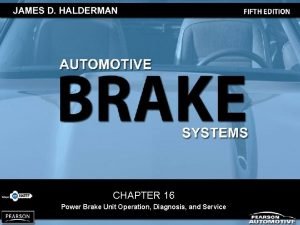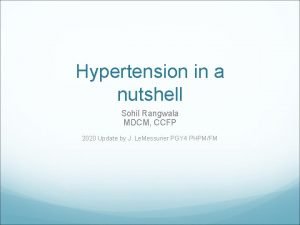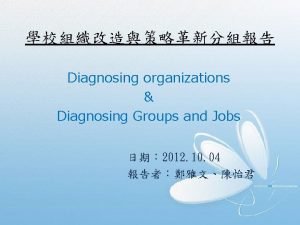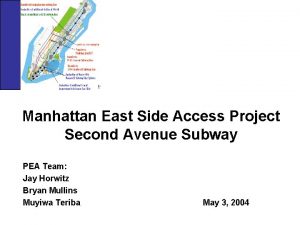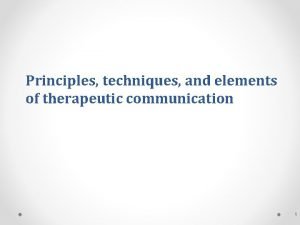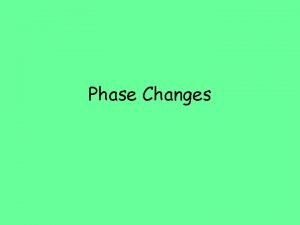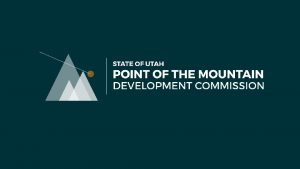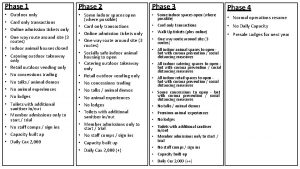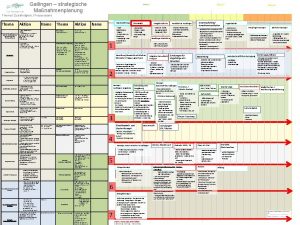Diagnosing is the second phase of the nursing





















- Slides: 21

Diagnosing is the second phase of the nursing process, in which the nurse interprets assessment data, identifies client strengths and health problems and formulate diagnostic statements

It is a clinical judgment about individual, family or community responses to actual and potential health problems / life processes – NANDA 2003 NANDA – North American Nursing Diagnosis Association

There are three process: Analyze Data Identify the health problems, risks and strengths Formulate diagnostic statements

There are five types of nursing diagnosis: Actual Diagnosis Risk Nursing Diagnosis Possible Nursing Diagnosis Syndrome Diagnosis Wellness Diagnosis

It is a client problem that is present at the time of the nursing assessment. It is based on the presence of associated signs and symptoms Example: Ineffective Breathing Pattern Anxiety

It is a clinical judgment that a problem does not exist, but the presence of risk factors indicates that a problem is likely to develop unless nurses intervention Example: Risk for infection, Risk for complication

It is one in which evidence about a health problem is incomplete or unclear Eg: An elderly widow who lives alone is admitted to the hospital. The nurse notices that she has no visitors and is pleased with attention and conversation from the nursing staff The nurse may write a nursing diagnosis of possible social isolation related to unknown etiology

It is a diagnosis that is associated with a cluster of other nursing diagnosis Eg: Disuse syndrome (long term bed ridden patients) Impaired physical mobility

It is one indicating a healthy response of a patient who desire a higher level of wellness Eg: Individual coping Family coping Potential for enhanced spiritual well being

There are three components: The problem (Diagnostic label) The etiology ( Related factors & risk factors) The defining characteristics

It Describes the patient response to health problems Eg: Activity intolerance Constipation

These are causative factors that have influenced the clients actual or potential response to the health problem The related phase identifies the etiology or cause of the clients response to health problem Eg: Activity intolerance related to generalized weakness or obesity or sedentary life style Constipation related to inadequate fluid intake or inadequate fiber intake

These are the cluster of signs and symptoms that indicate the presence of particular diagnostic label Eg: Impaired response to activity, weak, thready pulse, tachycardia, irregular pulse and shallow respiration

The diagnostic process uses the critical thinking skills of analyses and synthesis This process has three stages: Analyzing data Identifying health problems, risk & strengths Formulating diagnostic statements

It involves the following stages: Compare data against standards Cluster cues Identifying inconsistencies gaps and

After data are analyzed, the nurse and patient can together identify strengths & problems. This is primarily a decision making process

Most nursing diagnosis are written as two part or three part statements BASIC TWO PART STATEMENTS: It is also called PE format Problem (P) – statement of the patients response Etiology (E) – factors contributing to or probable causes of the response Example: Problem (P) related to Etiology (E) Activity intolerance related to generalized weakness or obesity

It is also called as PES format & includes: Problem (P) – statement of the patient’s response Etiology (E) – factors contributing to or probable causes of the responses Signs & Symptoms (S) – defining characteristics evidenced by the client Example: Problem related to etiology as evidenced by signs and symptoms Activity intolerance related to generalized weakness as evidenced by fatigue

It is a statement of nursing and judgment to a refers condition that nurses are licensed to treat It is made by a physician and refers to a condition that only a physician can treat

NURSING DIAGNOSIS MEDICAL DIAGNOSIS It is made by nurses and It is made by physician condition that nurses are and a condition that only licensed to treat a physician can treat It is a statement nursing judgment of It is a statement medical judgment of It describe a patients It describes a patient’s physical, sociocultural, specific pathophysiologic psychologic and spiritual responses to an illness or a health problem

NURSING DIAGNOSIS MEDICAL DIAGNOSIS These responses vary among These responses are fairly individuals uniform from one client to another The patient’s nursing The patient’s medical diagnosis change as the diagnosis remains the same client’s response change for as long as the disease process is present Nursing diagnosis relate to Nurses are obligated to carry the nurse’s independent out physician prescribed functions treatment (dependent function) Eg: Tepid sponging for fever Eg: Tab. Paracetamol 500 mg for fever
 Medical diagnosis and nursing diagnosis difference
Medical diagnosis and nursing diagnosis difference Diagnosing error in object detectors
Diagnosing error in object detectors Unit 5 quiz 1 power assist systems
Unit 5 quiz 1 power assist systems Caplan syndrome
Caplan syndrome Aobp vs obpm
Aobp vs obpm Cultural intelligence profiles
Cultural intelligence profiles Hypertensive emergency
Hypertensive emergency Diagnosing groups and jobs
Diagnosing groups and jobs 27 miles per gallon into kilometers per liter
27 miles per gallon into kilometers per liter Second avenue subway phase 3 timeline
Second avenue subway phase 3 timeline Mobile phase and stationary phase
Mobile phase and stationary phase Phase to phase voltage
Phase to phase voltage Mobile phase in chromatography
Mobile phase in chromatography Broad phase vs narrow phase
Broad phase vs narrow phase Normal phase vs reverse phase chromatography
Normal phase vs reverse phase chromatography Line vs phase voltage
Line vs phase voltage Normal phase vs reverse phase chromatography
Normal phase vs reverse phase chromatography Hplc reverse phase vs normal phase
Hplc reverse phase vs normal phase Which detector used in hplc
Which detector used in hplc Planning phase in nursing process
Planning phase in nursing process Principle of therapeutic communication
Principle of therapeutic communication Mental health nursing process
Mental health nursing process


